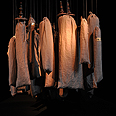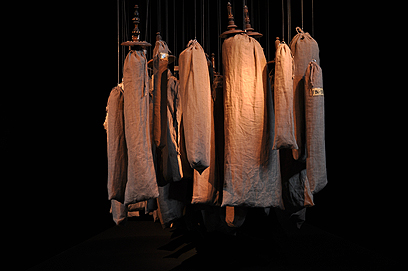
Torah stories: From Auschwitz to Yemen
Scroll which made it from Nazi concentration camp to Israel, 500 books from Lithuania rapped in sacks, two ancient Torah scrolls concealing Yemeni Jewry's history. Israel Storytelling Festival presents stories of the Book of Books
In honor of the Simchat Torah holiday, the Israel Storytelling Festival brought together several prominent Israeli figures, each holding a Torah scroll with a unique history. The personal story presented by the participants is intertwined with the story of the Jewish people.
The storytellers include former Chief Rabbi Yisrael Meir Lau and author Haim Be'er. Four of the panel members share with Ynet four true stories.
Torah scrolls journey from Auschwitz
The late Yaakov Helman, Yaakov Maor's grandfather, was murdered in the Auschwitz concentration camp, but managed – against all odds – to bring into the inferno a miniature Torah scroll made of antelope skin, after sewing another sleeve in his coat and hiding it inside.

'It found me.' Yaakov Maor with his grandfather's Torah scroll (Photo: Yair Maor)
The special Torah scroll was the only one of two which made it into the concentration camp. In any other situation, this Torah scroll would have likely been considered invalid, but not when it was the only one of two scrolls in Auschwitz.
For nearly a year it was read in the darkness, until the death march in which Maor's grandfather was killed when he bent down to tie his shoelaces and was shot by the Nazis.
His good friend, who was standing just a few steps apart and was familiar with the scroll's story, survived the death march. He married the aunt of Maor's mother and was the one who told the family about the Torah scroll's journey.
In 1975, young Maor traveled to Vienna as part of his work. He was known by the heads of the local community as a person who regularly visited shul.
During one of his visits, the community expressed its desire to donate two Torah scrolls to Israel. Maor found himself in the Jewish community's basements, facing a treasure of some 200 Torah scrolls. After two scrolls were selected to be transferred to Israel, the synagogue affairs manager asked Maor, "Have you ever seen a Torah scroll made of antelope skin?"
Maor says it's hard to describe how overwhelmed he was at that moment. He recalled the story of his grandfather's Torah scroll and decided to check if this was the same one.
From the stories he was told throughout the years, he knew that his grandfather was killed from a single gunshot, and because the scroll was hidden under his armpit, it was reasonable to assume that it contained silent evidence of the wound.
Another distinctive mark he expected to find on the scroll was rust. When he began rolling it up, he discovered signs of rust on the Torah portion read that week, as well as signs of the bullet which infiltrated through the scroll.
"The scroll found me. I wasn't looking for it," says Maor, who got to bring the Torah scroll to Israel.
500 Torah scrolls in Vilnius basement
Shamai Keinan, who for many years headed an association dedicated to bringing holy items from all across the world to the Jewish state – was involved in an operation aimed at rescue 500 Torah scrolls from Vilnius.
The unbelievable story of the scrolls was relayed by a partisan from the Vilnius ghetto, who knew that the Nazis and Lithuanians collaborated and gathered all the holy books of Jews sent to the camps in a church.
Lithuanian law defined the scrolls as Lithuanian property transferred to the national museum, with the aim of establishing a museum that would document the extinct Judaism after the planned annihilation of the Jewish people.

Torah scrolls on display in Hechal Shlomo (Photo: Naor Ankri)
After the State's establishment, for an entire decade, many diplomatic efforts were made to rescue the Torah scrolls. Dozens of appeals were made to the Lithuanian government in a bid to amend the law and define the scrolls as the property of the Jewish people.
For three years – with the help of Jewish lobbyists – the law was eventually amended, but even after the property was defined as Jewish the Lithuanian government refused to hand it to Israel.
The American administration, led by then-President George Bush, managed to persuade the Lithuanian government to transfer the scrolls to Israel. A delegation was tasked with finding a quick solution for bringing the Torah scrolls to the Jewish state. It was headed by Rabbi Yisrael Meir Lau and late politicians Lova Eliav and Dov Shilansky.
The problem was that El Al did not offer direct flights to Lithuania, and the cost of such a special flight amounted to some $40,000 those days.
Rabbi Melchior, who served at the time as minister of social and Diaspora affairs and deputy foreign minister, provided a bank guarantee on behalf of the State of Israel, while then-Transportation Minister Ephraim Sneh granted a special permit to the flight carrying the delegation members, youth movement representatives, the health minister and other diplomats.
Shamai says he arrived at the national library in the snowy and freezing weather, and was greeted with scowling faces. The delegation was taken down to a dark and dusty basement, where the 500 moldy Torah scrolls were found covered in grey sacks as if on their way to the gallows.
The Israeli team packed the scrolls in three containers. A press conference held immediately after the delegation's return was interrupted by Shamai, who presented one of the Torah scrolls' bloodstained cloth.
Most of the Torah scrolls were deemed invalid, and are presented today at the Hechal Shlomo Jewish Heritage Center in Jerusalem. The 18 scrolls that survived have been scattered between Jewish communities.
Maimonides' medical doctrine
Amos Rachamim, a youth instructor and a truant officer, related during the festival the story of two Torah scrolls of the Yemeni Jewry – one of them 400-year-old, which includes detailed explanations on growing medicinal herbs, inspired by the Maimonides' writings.
Many read the scroll, which was passed from generation to generation, and sought advice on daily problems.
Rachamim also revealed the story of the "al-Manzali" Torah scroll, written by Yehia Jamil – one of Yemen's greatest religious judges – about 300 years ago. The Muslims were the one who guarded it until the Jews returned from exile.
Jamil lived 30 kilometers from Sana'a and was recognized by Jews and Muslims as a saint. According to tradition, he wrote the Torah scroll with half of his body immersed in a ritual bath.
The scroll was passed from generation to generation until it reached Israel, at the Ein Shemer transit camp which took in many Yemeni Jews. Today it can be found at the synagogue in Moshav Naham.
Reading from Poland Rebbes' Torah scrolls
Two months before his son's bar mitzvah, Attorney Shlomo Nass – the husband of Knesset Member Lea Nass (Likud) – learned that a 100-year-old Torah scroll written by his grandfathers was in the hands of the Rebbe of Mukachevo.
Nass, a businessman and member of the board of directors of many companies, is an offspring of a dynasty of rabbis from Komarno.
The problem was that nothing could persuade the Rebbe of Mukachevo to remove the book, which survived the Holocaust, from his home. Nass who dreamed of seeing his son read from the holy scroll, traveled to New York and managed to convince the rabbi.
The boy was called up to read from the Torah scroll in synagogue, and the Nass family experienced an emotionally moving closure.
These stories and others were presented in detail at the Israel Storytelling Festival held at the Givatyim Theater, October 13-20
- Follow Ynetnews on Facebook










